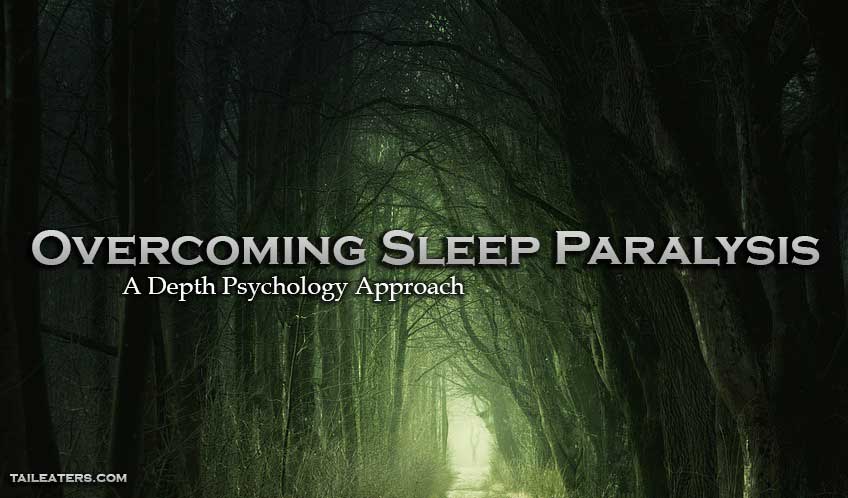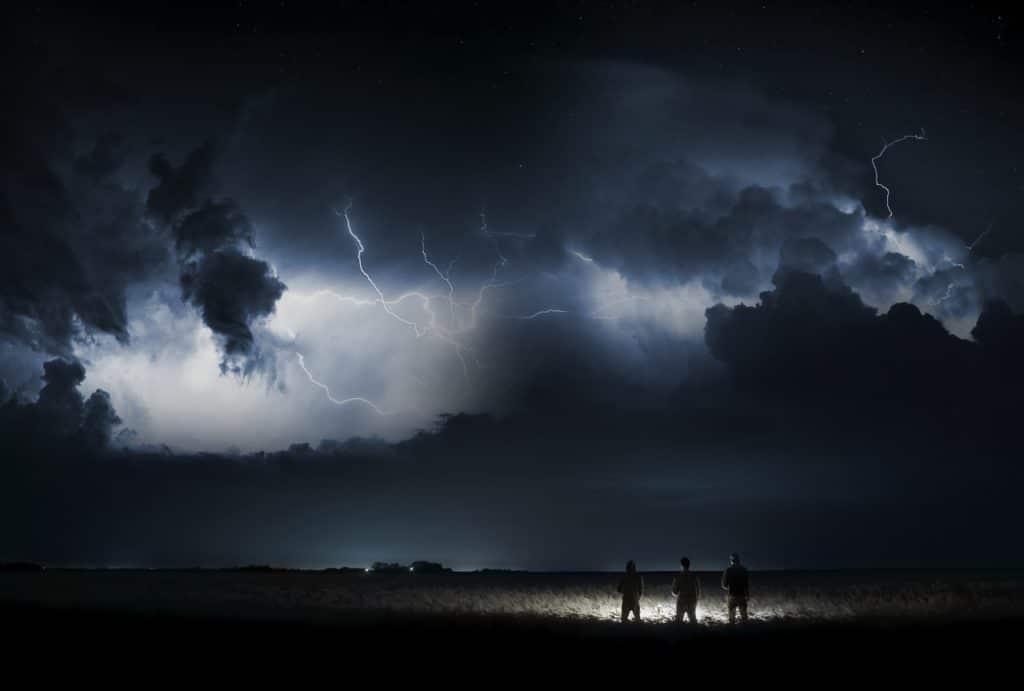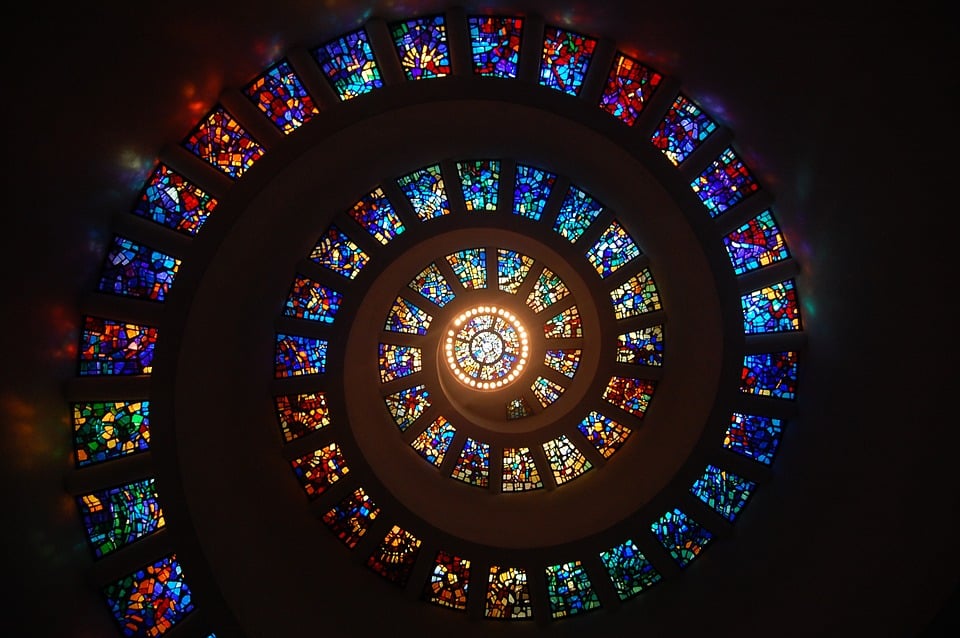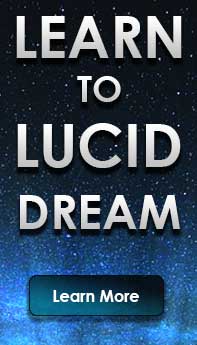
Overcoming Sleep Paralysis:
A Depth Psychology Approach
Depth psychology has focused on the waking elements of the individual after they have awoken from sleep, decoding the dreams of the previous night to understand the symbolic meaning and patterns that express the unconscious. Depth psychology has also found ways to interact with dream elements while awake through active imagination which helps engage the unconscious through active role playing while awake. But where depth psychology has shown its greatest success (in conscious experience) it has overlooked a possibly more powerful tool, engaging with the unconscious in dreams themselves through an often troubling hypnotic phenomenon in sleep called sleep paralysis.
Sleep Paralysis
Sleep paralysis and its associated hallucinations are often seen as undesirable. There is a small community of dreamers who have learned how to use the sleep paralysis experience to become aware in their dreams and to communicate with their unconscious; the specific techniques they use very closely parallel Jung’s process of active imagination. Those who have been successful report diminished fears of sleep paralysis and positive effects of sleep paralysis on their dreaming and in their waking lives.
Sleep paralysis is described as the feeling of being unable to move while sleeping followed by visual, auditory, or other hypnagogic hallucinations (Hurd, 2011, p. iii). Though rarely discussed, and perhaps therefore assumed to be uncommon, worldwide up to 40% of the population has come into contact with the experience at one time or another (Hurd, 2011, p. iii). In some countries those numbers are much higher. In Japan roughly 50% of those questioned had experienced at least one episode of sleep paralysis (Fukuda, Miyasita, Inugami, & Ishihara, 1987).

Paralysis during sleep is a natural neurological process that prevents sleepers from acting out their dreams (Popova, 2019). This mechanism, produced in the brainstem and for the most part remaining out of the awareness of the dreamer, is activated every time an individual dreams. While its usefulness during dreaming is apparent, the reason someone would experience sleep paralysis outside of that context is not entirely understood. Individuals have reported sleep paralysis triggered by specific geographical location, life stressors, and sleep disorders other than the sleep paralysis itself. Further, depth psychologists may inquire about how an individual’s state of mind or livelihood is in need of realization and integration and is expressing itself in an aggressive manor (Whitmont, 1991, p. 74) such as sleep paralysis.
As mysterious as the causes of sleep paralysis are, what is even more of a mystery is the associated hallucinations. Hypnagogia refers to sleep paralysis related hallucinations that can affect all five senses. Though hypnagogia can occur on its own, it is often believed to be caused by sleep paralysis. This grouping of two nearly independent experiences can make differentiating the two very difficult. Regardless, hypnagogia can occur while someone is either entering a hypnagogic state (from waking to sleeping) or a hypnopompic state (from sleeping to waking) (Steen, 2017).
In reviewing hundreds of cases of sleep paralysis, I have found that people experience and interpret hallucinations in a variety of ways. Hallucinations caused by hypnagogia can seem very real, ranging from hearing a sound, such as a radio playing, to feeling and seeing a person or animal in the room physically attacking the dreamer. Those who have such disorienting, even disturbing, experiences not only are rightly upset by them but find little support or mirroring in modern culture. Even though sleep paralysis is experienced by 40% of the population, it is rarely discussed seriously, appearing instead as a subject of horror film and folklore. Many sleepers who experience sleep paralysis often compare it to demonic rape and possession, which is for the most part rejected by modern culture as unworthy of discussion.
Sleep paralysis and its associated hallucinations have been documented under various names in many traditions around the world. Even the word nightmare has its foundation in sleep paralysis, mare being in relation to the old English name for a female incubus (Liberman 2009, p. 87). In the 2018 Netflix series The Haunting of Hill House one of the children experiences sleep paralysis, showing the child unable to move and then having visual hypnagogic hallucinations (Doyle, 2019).
Learn to Lucid Dream and Gain Rewards
![]()
Learn to lucid dream and complete tasks for re-life rewards.
Like the incubus of folklore or the example in The Haunting of Hill House, most sleep paralysis hallucinations result in an encounter with an archetypal entity that seems to come from outside the dreamer. They often experience the entity as coming into their bedroom through a door or window, and often these entities resemble shadowlike figures, demons, aliens, or angels. What makes these encounters most interesting is how often they are described very similarly across cultures (Hurd, 2011, pp. 43-47).
The emotional energy attributed to these encounters is also noteworthy. These entities are recognized by the emotional qualities that they produce in the individual as they respond, either by seeing the entity or by feeling it before the encounter takes place. Fear is one of the most frequently reported emotions when coming into contact with these archetypal forces; however, an immense power can often be felt as well. The emotional response from sensing the presence of the entity can also trigger the paralysis effects.
Though most reported cases of sleep paralysis and hypnagogia are terrifying, there are cases that are peaceful. In “Her Sweet Murmur” in DarkLore Volume I, Greg Taylor discusses historical accounts of hypnagogia as near-religious experience. The author makes that case that many prophetic accounts and interactions with angels happened while the encounterer was asleep. The author attributes these interactions to sleep paralysis and their associated hypnogogic hallucinations to the similarities in sensations before their encounters.
Regardless of the type of encounter an individual has, the encounters can be emotionally powerful and often disrupt the individual’s life. Often the encounters repeat, leaving the individual feeling helpless and looking for ways to stop it. Since Western culture predominantly looks toward outside factors (which still may contribute to the encounters), the internal psychological factors are often overlooked. The cross-cultural similarities or synchronicities in their experiences and the emotional response that the dreamer feels makes the case that these entities are archetypal in form, expressing themselves in the form of complexes, and should be treated as such when it comes to understanding their effects and helping the individual to understand their message (Jacobi, 1974, p. 27).
Archetypal Energy
Archetypes are identified by their emotional intensity and the ability to overcome the individual who tries to resist their influences. If we look at the emotional responses that are produced by the encounters during sleep paralysis, we can see how these, too, make an emotional response that can become overwhelming if resisted. Additionally, the hallucinations can also be the mechanism that causes the paralysis itself, which feels like an electrical shock through the body which if resisted can intensify and become painful. When the force of sleep paralysis is resisted, the phenomenon seems to mimic quite accurately what Jung described as archetypal energy that resonates as though it’s an electrical magnetic force (Whitmont, 1991, p. 112).
The universality of the sleep paralysis experience is another contributing factor of its archetypal nature. Individuals across cultures remark on their sensations and associated hallucinations in ways that are eerily similar. Symbolic representations during the paralysis experience include vampires, the succubus, witches, demons, and, most recently, Slender Man all have a prominent place in every culture and have made their way into popular media.
Even more surprisingly, the effects of sleep paralysis can be treated by engaging with the hallucination, merging with the entity through psychical contact, and ultimately passing through the entity. This tracks closely with depth psychologists’ approach to identifying repressed complexes in the shadow and passing through its gateway (Grice, 2016, pp. 45-47). What happens after the merging with the unconscious is also similar to what Jung describes as using the shadow as a gateway to the unconscious and as a gatekeeper to the other archetypes (Jung & Storr, 2013, p. 90). Those who use sleep paralysis as a means to lucid dreaming use sleep paralysis to enter the dream world consciously. This closely mimics the transcendent function, ultimately allowing the ego to realize the Self (Grice, 2016, p. 140).
Shadow Elements
Most interactions with sleep paralysis are considered negative, so we may look at the encounters with entities in sleep paralysis as an encounter with the individuals personal shadow. A depth psychologist can easily look at the attributes of the entity, often dark and shadowy, and the negative emotional energy such as terror, fright, sadness, and depression, that it releases, and conclude that these are shadow elements. Even the way a sleep paralysis encounter is processed fits the elements of shadow encounters, where once an individual has been able to process the sleep paralysis encounter by engaging with the entity, the entity will transform and an encounter will continue, often with the individual passing through a threshold or gateway (Grice, 2016, p. 45). It may take many encounters and assimilations of that encounter for an individual to work through whatever is causing the encounter to occur.
There are, however, a few contradictions to sleep paralysis as predominantly a shadow archetypal encounter. The visitation is often mixed in its gender relation to the dreamer, meaning that the entity may be male or female and may also change from encounter to encounter. Though the shadow element can be represented by figures of the opposite sex, it is more likely to be of the same sex (Whitmont, 1991, p. 163). As discussed before, not all encounters with sleep paralysis are negative in nature as angels and past relatives have been known to visit dreamers in this state, allowing the dreamer to feel optimistic upon waking. Although sleep paralysis may predominantly represent the shadow elements of the unconscious, it may not be limited to shadow archetypal energies alone.
Falling Asleep
Most of the negative physical aspects of sleep paralysis can be overcome by consciously relaxing the mind and body, allowing for the sensed energy to move through the body in the way that it desires. By relaxing, the individual can let the paralysis to hit a peak level and then feel as if they have been freed from their physical body or have an out of body type experience (Hurd, 2011, p. 64). This sensation is often felt as a sudden dropping feeling or passing (hence why we refer to going to sleep as “falling asleep”).
Jung discussed this falling sensation in his first encounter with what he later termed active imagination, saying, “I was sitting at my desk once more, thinking over my fears. Then I let myself drop. Suddenly it was as though the ground literally gave way beneath my feet, and I plunged down into the dark depths” (Jung, 1989, page. 179). What followed was an encounter with entities that bear striking similarities to those described by dreamers who have hypnogogic visitations. We can see the similarities between Jung’s active imagination state and the hypnogogic state. He may very well have accidently fallen into a trancelike state or even fallen asleep while reading at his desk and not been aware of the transition. Similar situations are found in encounters of sleep paralysis in which the individual thinks they are awake and seeing reality as it is but are in fact sleeping. Another example of this falling down is found in Dante’s Divine Comedy, when Dante is found falling into a hole through which he can enter the underworld (Johnson, 1986, p.165) (Grice, 2016, p. 51).
Even Jung’s spontaneous introduction into the active imagination state is similar in theme to the impulsiveness of sleep paralysis. Often those who suffer from their first encounter with sleep paralysis don’t understand why they suddenly started to have encounters; they seem to come out of nowhere. In identifying underlying causes, individuals who are having sleep paralysis often fall along the same lines as someone who has started a form of the individuation process: identifying with their unconscious, seeing that the world is different than their religious or cultural imposed beliefs, and searching for meaning that is inside their psyche rather than external. It would make sense that an emotionally powerful and psychologically troubling process such as sleep paralysis may occur to grab the attention of the dreamer and indicate great need for change (Grice, 2016, p. 120).
After Jung’s initial encounter with the unconscious through active imagination, he continues to seek encounters with the unconscious in new and creative ways. He started to engage with and record his encounters, resulting in the tomb of work which he called The Red Book (Jung, Shamda, Kyburz, & Peck, 2009). Though often we may see Jung as consciously choosing to encounter the unconscious, it very much could have been that Jung’s actual choice was to consciously go along with an initially unconscious process that was happening already. In terms of sleep paralysis and its associated visitations, these encounters with the unconscious continue to happen regardless of the conscious willingness of the dreamer, as though a doorway has opened that cannot be shut again. I know of no case in which sleep paralysis has not returned after the initial encounter.
Regardless of Jung’s situation in his introduction to active imagination, one thing is certain: Jung continued to develop a way to interact with his unconscious that was beneficial to him. If we are in fact interacting with archetypal forces in sleep paralysis as Jung was in active imagination, we could use these same techniques to assist others to relive their troubles during the night.
Sleep Paralysis Like Active Imagination
In active imagination we are welcoming the unconscious into the waking world so that we can build better lines of communication with it (Johnson, 1986, pp. 138-139). Unlike dreams, where messages are encoded into complex images for us to realize, in active imagination the unconscious takes on a more active role and can convey a message as a seemingly alive personality (Johnson, 1986, p. 139). Jung documented his encounters with his unconscious in The Red Book, describing his visitors as seemingly real interactive personalities that would not only tell him things but also take feedback from him. In this way he conveyed his desires to the unconscious, much as Job did in the Bible when he interacted with God (Jung, 1954/1968, pp. 255–272).
Through Jung’s interactions with his unconscious he realized that underneath his conscious awareness lay a world full of desires and needs that he would need to attend to if he was to live a fruitful life. He used active imagination to play with his unconscious and to understand himself better. He generated a proactive relationship with archetypal forces, something that sleep paralysis may be insisting that dreamers attend to (Grice, 2016, p. 117).
In hypnogogic visitations we find the dreamer in a similar situation, in which they come face to face with a seemingly living representation of their unconscious. As in active imagination, the messages are emotionally powerful and express urgency to the dreamer. The dreamer is often aware and, though unable to always identify that they are actually dreaming, are aware enough to be able to understand that they are conscious.
Hypnogogic visitations differ from active imagination in that the message is encoded and not very clear when taken at face value and are oftentimes hyper aggressive. Additionally, the dreamer often finds themselves paralyzed and unable to physically interact with their environment, which can magnify the individual’s emotional reaction.
Regardless of the differences between active imagination and sleep paralysis, there are enough commonalities that we can use the tools created by depth psychologists to interact with the unconscious and build communication.
The Benefits of Interacting with Hypnogogic Visitations
Many people who report that they have somehow overcome their sleep paralysis without any formal training seem to follow a specific process. At first, they realize that the experience itself is going to recur until they change something or react to it differently. Just as individuals can identify complexes and their patterns, sleep paralysis sufferers can notice patterns to eventually face the experience (Grice, 2016, p. 44). The initial reaction to the paralysis is to become fearful of the physical sensations and the visual hallucinations. However, once someone has had enough experience with the effects, a new approach is often used. This often comes in the form of fighting.
In fighting the effects of the paralysis, the intensity of the paralysis will build up for the sleeper (Hurd, 2011, p. 4). This will continue and can become painful. In fighting the hallucinations or actively, aggressively attacking the visitation, it may go away for the night, but it will return, next time more aggressive in their actions. In being able to fight off the visitation initially, the dreamer may experience a form of ego inflation, feeling as though they are in control and powerful enough to repress the archetypal energy that is trying to emerge (Johnson, 1986, p. 174). This could be beneficial for someone who has a deflated ego, but for the rest it can be negative.
After the inevitable return of paralysis and its associated visitations, the dreamer will come to realize that their initial overpowering was a temporary fix and that a more long-term solution is needed. The dreamer must now try to decipher the message that lies inside the experience. This entails first relaxing enough that the paralysis effects will reach their peak and pass through the body, followed by consciously asking the visitations what their purpose is. In doing so the individual may find a dreamlike encoded message specific to the dreamer that needs to be applied to their waking life.
Once the dreamer understands the message and makes the necessary changes, the paralysis and visitations will also change. The paralysis effects may completely go away for a time, returning when another message is ready for the dreamer; the visitations also may change depending on the type of message that is needed to be conveyed in the future. Sleep paralysis in this view may operate in the same way as a waking neurotic expression, causing ticks (or in the case of sleep paralysis, strong electrical feedback-like effects), due to the complexes not being expressed and becoming expressed through the psychical body. Reliving the underlying pressure improves the individual’s life.
The Negatives
Just as they can in active imagination, an individual can have sleep paralysis spontaneously or they can learn to induce it. Many lucid dreaming guides offer techniques to induce sleep paralysis. Dangers come from these interactions if the individual’s ego is unprepared or not stable enough to take the interaction. Though it is rare, ego possession, a feeling that one is losing their mind, or loss of the connection to waking reality can occur with sleep paralysis (Cloud, 2011). It is important that the same precautions are used when experiencing sleep paralysis as are used with active imagination, such as speaking with a Jungian analysist or depth psychologist (Johnson, 1986, p. 137).
The Four-Step Approach
Since we have already shown the similarities of sleep paralysis and active imagination, it would be safe to assume that safe and constructive techniques used to facilitate the latter could also be useful in sleep paralysis encounters. In Robert Johnson’s book Inner Work we find a concise, comprehensible approach to active imagination. He breaks down his process into four steps, some of which don’t need much attention, as they naturally happen in cases of sleep paralysis:
- Invite the unconscious
- Dialog and experience
- Add the ethical element of values
- Make it concrete with physical ritual
(Johnson, 1986, p. 160)
In the case of sleep paralysis, we can see that the first step is already initiated for the most part. The individual, like it or not, is experiencing the unconscious trying to express itself. If the visual representation has not taken effect, additional steps may be needed to bring the encounter closer to conscious awareness. Practicing bringing the mind closer to the imagination through ignoring the psychical sensations brought on by the paralysis may be enough to start the visualizations (Johnson, 1986, p. 165). Additionally, if the dream experience seems overpowering (as it often can be with sleep paralysis), inviting the unconscious into the waking world and building a safe dialog with it is also an option. Whatever method is used to understand and realize the shadow (in this case the sleep paralysis and what message it is trying to convey), the dreamer must set themselves on firm ground and face the experience head on (Grice, 2016, p. 47).
Imagining the sleep paralysis experience as though it is currently happening while awake and asking the dream experience what it wants can be useful to resolving the issues (Johnson, 1986, p. 171). In doing so, the dialogue of the dream can continue, and the desires that reside behind sleep paralysis and its effects may be better understood.
Once dialog can be generated it is important for the dreamer to take an ethical stance on boundaries where the dream world is able to extend into the affairs of the dreamer. As discussed before, there are some negative effects of working with sleep paralysis that also apply to active imagination. Setting up ethical boundaries will help alleviate some of these negative aspects. The goal in active imagination is not to give up control to the fantasy of the dream but to build a dialogue (Johnson, 1986, p. 182).
Once the initial case of sleep paralysis has happened, it seems to be part of the individual’s life forever and a ritual act needs to be added into the daily life to keep the newly found dialog alive. Doing some type of physical ritual before going to bed that opens up the dreamer’s willingness to have dialog will help elevate further sleep paralysis type attacks (Johnson, 1986, p. 196). Writing down all the occurrences of sleep paralysis, including the active imagination elements, is essential to remembering the process, identifying the patterns, and keeping the dreamer grounded (Johnson, 1986, p. 180).
Ecopsychology Influences on Archetypal Forces
Ecopsychology bases the idea that archetypal forces also affect areas of the earth in its formation and memory and that these forces can express themselves in dreams. In his paper “Introduction-Summoned by the Voice of Place” Dr. Craig Chalquist describes in great detail his encounter with an archetypal force that expressed itself to him in a dram as being the representation of San Diego (Chalquist & Gomes, 2007, p. 2). Though not specific to sleep paralysis, his encounter did closely resemble a hypnogogic visitation and may shed some light on how location can affect a dream and paralysis itself.
There is a growing hypothesis that sleep paralysis is also location based, or at least that location has some influence on sleep paralysis. One interesting example of this phenomenon came from a self-study of an individual in Hawaii who would have frequent sleep paralysis while sleeping on top of lava tubes. In my personal experience, sleep paralysis has occurred in some locations at much higher rates than in others, regardless of other contributing factors such as stress levels or sleeping habits. Associated visitations also change based on location, as one location may present a specific encounter with a ghost or demon, while another location may manifest itself as a gnome. In his book The Terrors That Come in the Night, Dr. David Hufford’s documents a number of cases of sleep paralysis that include shared instances based on location. In one case, Hufford interviews a number of students all sleeping in the same house who experience sleep paralysis and visitations that cease after moving away from the location (Hufford, 1989, pp. 147–210). If location influences sleep paralysis, it is possible that the variations in the electrical magnetic field throughout the earth’s surface may be a cause.
In understanding our relationship to our surroundings and how the earth and its anima mundi responds to us, we may become more aware of what the associated archetypal forces are telling us. Using active imagination in the dream space may provide a way to realize what they desire.
Conclusion
Sleep paralysis can be a terrifying and often dislodging experience to the psyche, as it is unexpected and potentially traumatizing. The experience itself is not discussed or taken seriously by modern sleep professionals. Due to the stigma surrounds sleep paralysis and hypnogogic visitations, sufferers often see no way to end the experience, finding it debilitating. Surrounding these experiences are strong negative religious stigmatizations that make the experiencer prone to think something is wrong with them spiritually. Sleep paralysis, however, can be used as a powerful tool to communicate with the unconscious, a process that can lead to positive changes and self-growth. Using relaxation techniques in conjunction with active imagination, sleep paralysis can become a transcendental process that contributes to individuation and, ultimately, a better relationship with the Self.
References
Chalquist, C., & Gomes, M. E. (2007). Terrapsychology: Re-engaging the soul of place. New Orleans: Spring Journal Books.
Cloud, J. (2011, January 15). The Troubled Life of Jared Loughner. Retrieved from http://content.time.com/
Doyle, M. (2019, May 07). Experts Explain That Freaky Sleep Paralysis Situation In “The Haunting of Hill House.” Retrieved from https://www.bustle.com
Fukuda, K., Miyasita, A., Inugami, M., & Ishihara, K. (1987). High Prevalence of Isolated Sleep Paralysis: Kanashibari Phenomenon in Japan, Sleep, 10(3), pp. 279–286.
Le Grice, K. (2016). Archetypical reflections: Insights and ideas from Jungian psychology. London: Muswell Hill Press.
Hufford, D. (1989). The terror that comes in the night: An experience-centered study of supernatural assault traditions. Philadelphia: University of Pennsylvania Press.
Hurd, R. (2011). Sleep paralysis: A guide to hypnagogic visions & visitors of the night. Los Altos, CA: Hyena Press.
Jacobi, J. S., & Manheim, R. (1974). Complex: Archetype: Symbol in the psychology of C.G. Jung (3rd ed.). Princeton: Princeton University Press.
Johnson, R. A. (1986). Inner Work: Using Dreams and Active Imagination for Personal Growth. New York: HarperOne.
Jung, C. G. (1961/1973). Memories, dreams, reflections. New York: Vintage Books.
Jung, C. G. (1968). Psychology and Religion West and East (R. F. C. Hull, Trans.). In H. Read et al. (Eds.), The collected works of C. G. Jung (Vol. 11 pt. 1, 2nd ed., pp. 255-272). Princeton, NJ: Princeton University Press. (Original work published 1954)
Jung, C. G. (1989). Memories, dreams, reflections (April 1989 ed.). New York: Vintage Books.
Jung, C. G., Shamdasani, S., Kyburz, M., & Peck, J. (2009). The red book. New York (N.Y.): W.W. Norton.
Jung, C. G., & Storr, A. (2013). The essential Jung (2013 ed.). Princeton: Princeton University Press.
Liberman, A. (2009). Word origins – and how we know them: Etymology for everyone. Oxford: Oxford University Press.
Popova, M. (2019, March 04). What the Science of “Sleep Paralysis” Reveals About How the Brain Works. Retrieved from https://www.brainpickings.org/2014/05/07/dueling-neurosurgeons-kean/
Steen, C. (2017). Synesthetic Photisms and Hypnagogic Visions: A Comparison. Multisensory Research,30(3-5), 199-205. doi:10.1163/22134808-00002557
Taylor, G. (2007). Darklore. Brisbane, Australia: Daily Grail Pub.
Whitmont, E. C. (1991). The symbolic quest: Basic concepts of analytical psychology (1991 ed.). Princeton, NJ: Princeton University Press.
Lee Adams is a Ph.D. candidate in Jungian Psychology and Archetypal Studies at Pacifica Graduate Institute and host of Cosmic Echo, a lucid dreaming podcast, and creator of taileaters.com, an online community of lucid dreamers and psychonauts. Lee has been actively researching, practicing, and teaching lucid dreaming for over twenty years.
Join the Discussion
Want to discuss more about this topic and much more? Join our discussion group online and start exploring your consciousness with others like yourself





Recent Comments